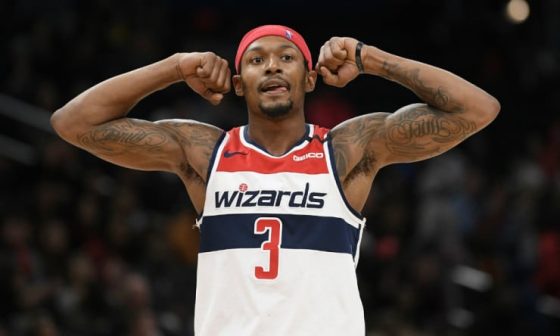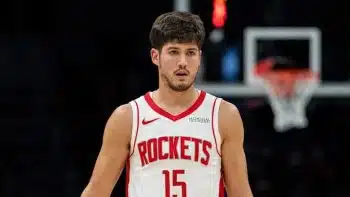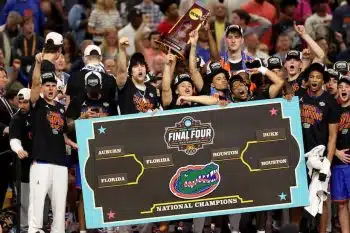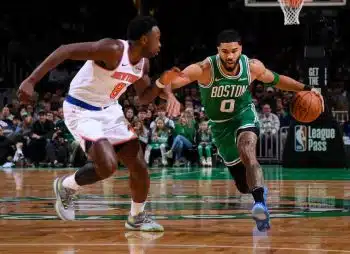NBA
NBA Daily: Elite Scorers Redefining What’s Possible

The NBA has had a number of different eras throughout its existence. The modern era of basketball began sometime between 1998 and 2003. Since the modern era and even before, it’s been extremely rare that two or more players average 29 points per game or more in the same season.
It’s actually only happened four times in the past 17 seasons: In 2005-06, Kobe Bryant (35.4), Allen Iverson (33.0) LeBron James (31.4) and Gilbert Arenas (29.3) all accomplished it; it happened again in 2009-10, when Kevin Durant (30.1) and James (29.7) did so; another time in 2015-16, when Stephen Curry (30.1) and James Harden (29.0) both did so; and once again in 2016-17 with Westbrook (31.6) and Harden (29.1).
The last time that four or more players averaged at least 29.0 points per game was that ’05-06 campaign, and the time before that was all the way back in 1987-88.
And yet here we are, more than halfway through the 2019-20 season with five players currently averaging at least 29.0 points per game. FIVE!
Presently, Harden (34.9), Bradley Beal (30.4), Trae Young (29.6), Giannis Antetokounmpo (29.6) and Damian Lillard (29.4) are all averaging more than 29.0 points per game.
And while drawing a line in the sand at that number might feel arbitrary, it’s a very real barrier that there few have broken through. And remember, there have been five seasons since 2003-04 that the NBA scoring champion averaged less than 29.0 points per game.
Before we get too far, it’s worth pointing out that this list could be even longer. Three of the very best scorers on the planet aren’t on the list for a variety of reasons: Curry, Westbrook and Durant.
Westbrook is still getting acclimated to playing alongside Harden in Houston, but he’s averaged more than 32 points per game since 2020; and if he averages 32.25 points per game over the final 20 games, he’ll finish the year at exactly 29.0. Meanwhile, Durant will miss the entire 2019-20 season and Curry has been sidelined for the majority of it. So while this season has forced many to rethink what’s possible, it could have been even crazier.
But it’s not as if the NBA just recently received an influx of scorers. Sure, there are some newcomers on the list, but it’s not as if the top scorers in 2019-20 are hands down better scorers than we’ve seen before. So what’s driving the uptick? This writer posits a theory that points to two stylistic changes: More shot attempts and a willingness to shoot the ball from beyond the three-point line.
First, a bit about the players’ willingness to take deeper shots. The deep three burst onto the mainstage fairly recently. Curry made sure we were all aware of it in Feb. 2016, when he sealed a game against the Durant and Westbrook-led Oklahoma City Thunder. That wasn’t the first time a player launched a long three-pointer, but it might have been the first time it was done and everyone watching assumed it had at least as good of a chance of going in. But one player isn’t the rule, he’s the exception.
However, since that night, we’ve seen Damian Lillard casually take and make 30-footers in the 2019 playoffs with perfect form. Trae Young has launched more than his share in his short time in the league, too. And then there’s LeBron James, who has made at least two 30-plus footers in only the last week – both of which were taken as if to say, “anything you can do, I can do better.”
Since 2003-04, two main things have changed: Star players are now also three-point shooters — and they’ve annexed lots of additional space from which they shoot — but coaching plays an equally important role in players taking longer three-pointers, as well. Modern coaches have relinquished some control for the greater good. Can you imagine Phil Jackson or Jerry Sloan allowing their players to remain in the game after shooting a 30-footer with 17 seconds left in the shot clock? Unlikely would be a generous way to put it. But modern coaches understand that it’s in their best interest to let their players play with freedom and pace.
The other integral aspect that has enabled more players to score at a flabbergasting pace is….pace. In basketball terms, pace is defined as the number of possessions per 48 minutes a team has. It’s a fairly straight forward concept. And ever since coach Mike D’Antoni showed off his “seven seconds or less” offense, teams have done their best to replicate it — despite the fact that it was publicly disparaged and disregarded as a fad.
A quick examination of the average pace across the league reveals that it has quickened pretty dramatically over the last few decades. The average pace in 2019-20 is 100.2. Last season, that number was 100.0. The year prior, 97.3. and it continues on that exact upward trajectory back to 2003-04, when the average pace was only 90.1. Pace affects the scoring average of elite players very directly because with a faster pace comes more possessions, which translates into additional touches for a team’s go-to scorer.
Basketball Insiders caught up with the New York Knicks’ defensive anchor, Mitchell Robinson, to discuss spoke the increase in elite scorers around the league.
“Yeah, I think it’s more just more field goal attempts,” Robinson said. “If I’m in the paint, not too many guys come down there. Some guys don’t care and come anyway. But most take outside shots instead of coming in. Leads to more points, long rebounds, more possessions.”
But field goal attempts are only part of the equation. Players have to convert field goal attempts, and NBA defenses continue to learn new schemes to keep players from touching the ball.
And yet, elite players are scoring more than ever before. Spoiler alert: It’s because they’re that good.
“Players are just getting sharper and working harder on their craft,” continued Robinson. “LeBron (James) been shooting those half-court shots in pre-games for a while (whereas other greats might not have). So if he takes that in-game, it’s gonna be like a warm-up.”
The uptick in elite scorers’ averages can be mostly attributed to an increased pace, as well as a more open game thanks to players shooting from a longer range. These innovations have made the game more aesthetically pleasing, but they’ve also enabled players to be more effective than ever before.
We are currently experiencing an offensive renaissance. The last few years showed us the speed at which basketball can be played, and this season shows that elite players must be picked up the second they cross half-court. When thinking back to the 1990s, five or more players averaging 29.0 points per game or more might’ve seemed impossible.
It’s exciting to consider what unattainable and unwritten rules will be challenged next.











